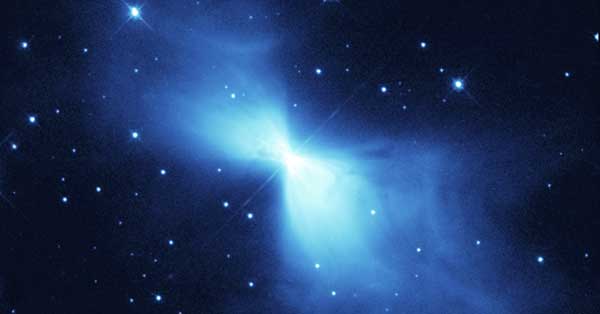The Universe as Kitchen
Cosmic ovens, nebular refrigerators, and the predictive power of physical law

In a footnote to the Jorge Luis Borges short story “The Library of Babel,” about a gigantic library that contains all books of a particular length composed using a particular alphabet, Borges distills the insight that animates the story: “It suffices that a book be possible for it to exist.” The number of fixed-length combinations of a small number of characters, while enormous, is not infinite, so a large enough library should, just by luck, have a very good chance of housing any conceivable book.
A similar statement can be made about the universe we live in. Just a few physical laws govern all its vastness, so if these laws allow for something to occur, there’s a good chance it will occur at some point in space and time. One illustration of this principle is the coldest region in the known universe, but before we get to it, let’s start with something more mundane: we are living in a universe-sized microwave oven.
A phenomenon discovered in 1963 called the cosmic microwave background, or CMB, is radiation left over from the Big Bang that permeates all of space. Its temperature is 2.7 Kelvin (about -455°F) and was higher in the past, so everything in the universe has been cooking at 2.7 K or hotter since the Big Bang. It seems to follow naturally that no place in the universe could be colder than this temperature, just as every part of a ham baking in a 450-degree oven will, eventually, heat up to 450 degrees.
In 1997, astronomers measured the temperature of gas escaping from the Boomerang Nebula, a giant cloud of gas and dust located about 5,000 light-years from Earth, and found it to be right around 1 K, less than half the absolute temperature of the CMB. This is the equivalent of opening up a 450-degree oven to find a chunk of dry ice.
The Boomerang Nebula’s unexpectedly low temperature is not a blow to the laws of physics but rather a striking example of nature’s inventiveness within the confines of those laws. And to explain the source of this cosmic cooling, it’s helpful to boomerang, er, to bring the discussion back to Earth and consider low-temperature experiments that take place daily in physics laboratories all over the world.
According to Guinness World Records, the coldest ambient temperature ever recorded on Earth is -129°F, or 183 K, measured in Vostok, Antarctica. By comparison, the temperature of liquid nitrogen, which is commonly available to scientists and costs about as much as milk, is about -321°F, or 77 K. How is it possible to make something so much colder than the coldest place on Earth?
The temperature of an object is a measure of the motional energy of its molecules, so to make something colder, its molecules must be slowed down by extracting energy. For a gas, a good way to extract energy is by making it push against a piston. This is how car engines work. We don’t normally notice that a car’s exhaust is much colder than the inside of the engine, but if it weren’t, the engine wouldn’t run. By repeatedly sending a gas through a piston-driven compression-and-expansion cycle, it can be continuously cooled until it condenses into a liquid. Such a process was first used in the late 19th century to liquify air, and is also used today to make liquid nitrogen.
Of course, there are no giant pistons floating around in outer space, but a piston isn’t the only thing an expanding gas can expend its heat energy on. It turns out that, under the proper conditions, an expanding gas will expend energy on itself.
Gas molecules have a weak attractive force, called the van der Waals force, pulling them together. For the distance between molecules to increase, as happens during expansion, energy must be used to overcome the van der Waals attraction and pull the molecules farther apart, just as it takes energy to stretch a rubber band. For a gas expanding in isolation, that energy comes from the motion of its molecules, causing it to cool.
So there we are: cooling upon expansion is the mechanism responsible for the Boomerang Nebula’s low temperature. The nebula is ejecting gas into surrounding space; this gas expands so rapidly that it cools at a faster rate than the CMB can heat it up, which has allowed it to reach a temperature of 1 K. From the size of the cold gas cloud and its expansion speed, it appears that this cosmic refrigerator has been running for at least 1,500 years.
Because the Boomerang Nebula’s cooling is governed by well-known principles, someone familiar with those principles could have predicted the effect. And it turns out that someone did predict it, several years before it was discovered. More than one person predicted it, actually, including one of its eventual discoverers, Raghvendra Sahai of the Jet Propulsion Laboratory in Pasadena, who was then able to confirm his predictions with observations. That, in the end, may be the deepest testament to the power of the universality of physical laws: someone can describe a situation allowed by known physics that has never been observed and reasonably expect to find it somewhere in the universe.
One final footnote: expansion cooling was also the technique used the first time a temperature colder than 2.7 K was achieved on Earth, by the Dutch physicist Heike Kamerlingh Onnes a century ago. So Kamerlingh Onnes unknowingly borrowed a cooling mechanism from an astrophysical phenomenon that hadn’t been observed (the Boomerang Nebula refrigerator) to surpass a fundamental temperature limit that hadn’t been discovered (the CMB oven). Whether one is a nebula or a man, the laws of nature delimit possibility in the same way.


